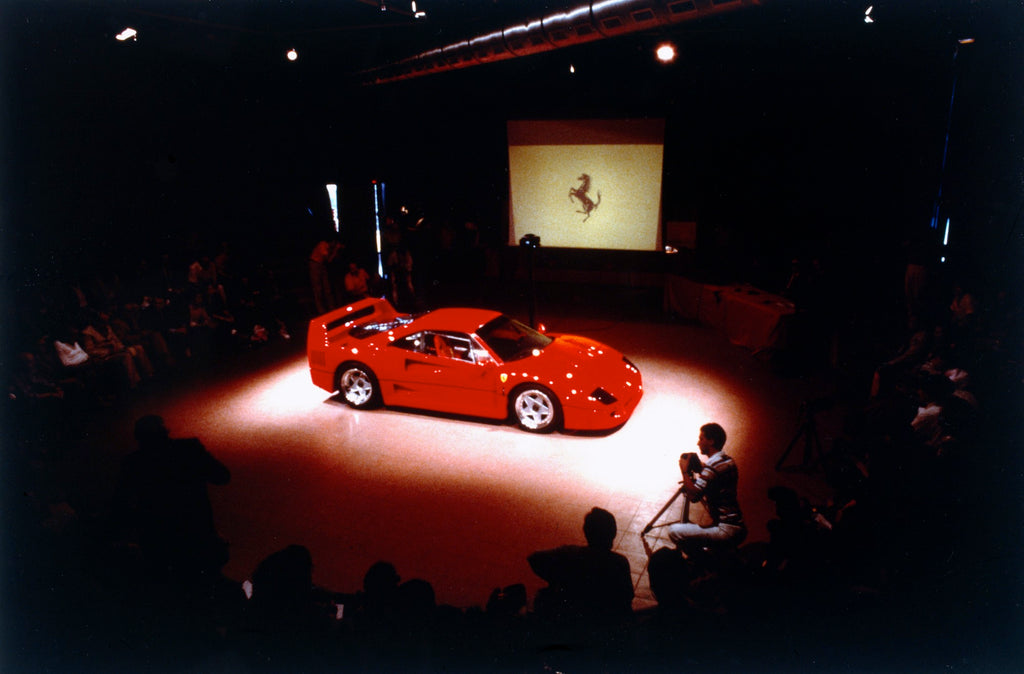
The last car personally approved by Enzo Ferrari
Thirty-five years ago today, on the 21st of July 1987, Ferrari unveiled a car at the Civic Centre in Maranello that would change the world. The F40 would become a symbol of the era, a masterpiece of raw engineering and style, the definitive driver’s car. It was the ultimate expression of Ferrari, utilising every raw mechanical and technological advance to create the ultimate race car for the road. It would signal the end of an era for performance cars in general, as electronic driver aids became more and more commonplace, as well as for the Ferrari brand, as Enzo would pass away just 24 days after witnessing the launch of his final legacy.
Discover the Ferrari F40 at scale >

The F40’s roots can be found as early as 1984, when Ferrari started development of the 288 GTO Evoluzione for the fabled Group B category of FIA-sanctioned racing. However, Group B racing was sensibly scrapped, leaving Ferrari with five cars and some head scratching about what to do with all the time, money, and remarkable engineering that had gone into the project. The decision was made to turn the 288 GTO into a road-going machine. Nicola Materazzi, father of the 288 GTO and its Evoluzione counterpart, was tasked to build the car, whilst the body was designed by studio Pininfarina. The F40 was developed in just thirteen months in time for the iconic marque's fortieth anniversary. At the time of its launch, it was Ferrari's fastest, most powerful, and most expensive car.

The Ferrari packed advanced engineering into its 2450mm wheelbase, including a twin-turbo V8 power unit and a lightweight Kevlar and carbon composite body. And yet, it was not a spaceship like the main rival, the Porsche 959. If the Porsche was a glimpse into the technology-laden future, the F40 was heralded as the most distilled, most satisfying version of the old ways of doing things. It had none of the electronic nannies now standard in every modern performance car. It did not use trick engine mapping and traction control to augment lap times. No power steering, power brakes or ABS to reassure the driver. Weight was kept to a minimum: the composite body panels were built for strength and low weight; Lexan-clothed windscreen was used instead of glass; and the interior was sparse to say the least, with no sound system, glove compartment or elaborate trims or upholstery. The F40 demanded the utmost attention and focus. Give it that, though, and it would give back the best driving experience of any car on the road at the time.

1311 examples of the F40 were built from 1987 to 1992, with 213 arriving in the United States. Racing versions, the LM and GT-E, were developed by Michelotto in Padova from 1994 to 1996 and enjoyed success for a number of years in European GT racing in the hands of privateers.

Models of the Ferrari F40 are currently in build at 1:8 scale, with batches of the European, US and Competizione specifications all expected to be completed by November. We would like to take a moment to remind customers interested in these models that our prices are increasing from the 1st of August, and any deposits placed before then will be honoured at the current prices. Models at 1:18 are scheduled in our build plan, but sadly this batch will not commence until next year. We advise all customers interested in the smaller scale F40 to register their interest on our website.

